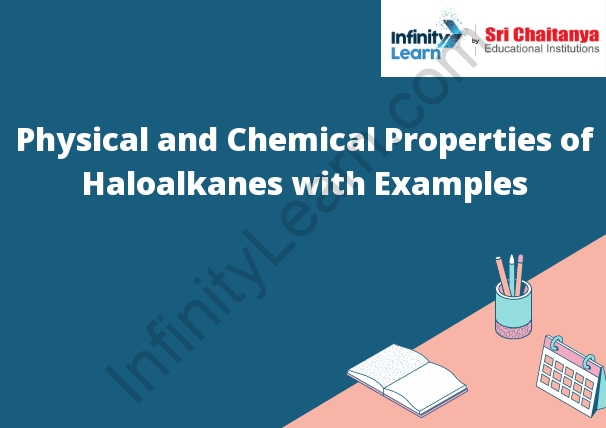Table of Contents
What are Haloalkanes?
Haloalkanes, also known as alkyl halides or halogenoalkanes, are a class of organic compounds that contain one or more halogen atoms (fluorine, chlorine, bromine, or iodine) bonded to carbon atoms. They are derived from alkanes by replacing one or more hydrogen atoms with halogen atoms.
Haloalkanes can have a general molecular formula of CₙH₂ₙ₊₁X, where X represents a halogen atom. The halogen atom is typically attached to a sp³ hybridized carbon atom, resulting in a tetrahedral geometry around the carbon atom.
Haloalkanes can be classified as primary, secondary, or tertiary, depending on the number of carbon atoms directly bonded to the carbon atom carrying the halogen:
- Primary Haloalkane: A primary haloalkane has one carbon atom directly bonded to the carbon atom carrying the halogen.
- Secondary Haloalkane: A secondary haloalkane has two carbon atoms directly bonded to the carbon atom carrying the halogen.
- Tertiary Haloalkane: A tertiary haloalkane has three carbon atoms directly bonded to the carbon atom carrying the halogen.

What are Haloarenes?
Haloarenes are a type of aromatic hydrocarbon that contains a halogen atom bonded to an aromatic ring. They are typically colorless, volatile, and toxic. Some common haloarenes include chlorobenzene and bromobenzene. The simplest haloalkane is methane, which contains one hydrogen atom and one chlorine atom. Methane is a gas at room temperature and has a characteristic pungent odor. Other haloalkanes, such as chloroethane and chloroform, are also gases at room temperature. However, haloalkanes that contain more than one halogen atom can be liquids or solids at room temperature.
What are the Physical Properties of Haloalkanes?
Haloalkanes are organic molecules that contain one or more halogens attached to a carbon atom. The halogens can be fluorine, chlorine, bromine, or iodine. Haloalkanes are liquids or gases at room temperature. They have a characteristic unpleasant odor. They are non-polar and insoluble in water.
Haloalkanes are a type of organic compound that contains one or more halogens atoms. The physical properties of haloalkanes can vary depending on the number and type of halogen atoms present. In general, haloalkanes are colorless, volatile, and flammable.
What are the Chemical Properties of Haloalkanes?
The chemical properties of haloalkanes are that they are all soluble in water and they all have a polar C-halogen bond. This polar bond causes the haloalkane to be soluble in water and also allows the haloalkane to react with other polar molecules. Haloalkanes are relatively non-polar and have low water solubility. This means that they are not very soluble in water, but are soluble in other organic solvents. Haloalkanes are also flammable and can be easily ignited.
What are the Physical and Chemical Properties of Haloarenes?
Haloarenes are a group of chemicals that have a haloalkane group attached to an aromatic ring. The haloalkane group is made up of a carbon atom bonded to a halogen atom, usually chlorine or bromine. The aromatic ring is made up of a group of six carbon atoms arranged in a ring.
The physical and chemical properties of haloarenes vary depending on the type of haloalkane group attached to the ring. Some haloarenes are liquids, while others are solids. Some haloarenes are volatile, meaning they evaporate easily, while others are non-volatile.
The chemical properties of haloarenes depend on the type of haloalkane group attached to the ring. Some haloarenes are very reactive, while others are not very reactive.
Examples of Haloalkanes
Here are some examples of haloalkanes, along with their chemical formulas and common names:
- Chloromethane (CH₃Cl) – Also known as methyl chloride, it is a colorless gas used as a refrigerant, solvent, and in the production of silicones.
- Dichloromethane (CH₂Cl₂) – Commonly called methylene chloride, it is a volatile liquid used as a solvent in various industrial processes, paint stripping, and as a degreaser.
- Trichloromethane (CHCl₃) – Known as chloroform, it is a volatile liquid once used as an anesthetic but now primarily used in laboratories and as a solvent.
- Tetrachloromethane (CCl₄) – Also called carbon tetrachloride, it is a colorless liquid once used as a solvent and fire extinguishing agent but has been phased out due to its toxicity.
- Bromomethane (CH₃Br) – Also known as methyl bromide, it is a fumigant used in agriculture to control pests and as a precursor in organic synthesis.
- Iodoethane (C₂H₅I) – Also called ethyl iodide, it is a colorless liquid used as a reagent in organic synthesis.
- 1-Chlorobutane (C₄H₉Cl) – A primary haloalkane used as an intermediate in the synthesis of pharmaceuticals, pesticides, and other organic compounds.
- 2-Bromopropane (C₃H₇Br) – Also known as isopropyl bromide, it is used as a solvent and in the synthesis of pharmaceuticals and other organic compounds.
- 1-Iodobutane (C₄H₉I) – A primary haloalkane used as an alkylating agent in organic synthesis.
- 1,1,1-Trichloroethane (CH₃CCl₃) – A colorless liquid used as a solvent, degreaser, and in the production of vinyl chloride monomer.
These are just a few examples of haloalkanes, and there are many more compounds with varying structures and applications within this class of organic compounds.






